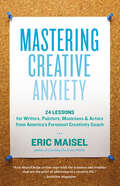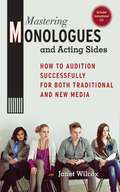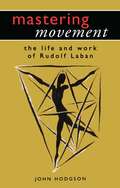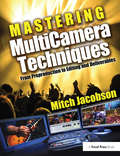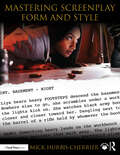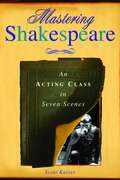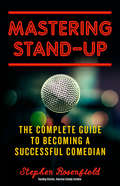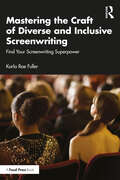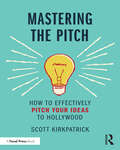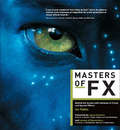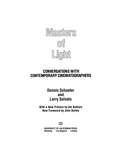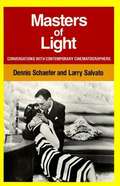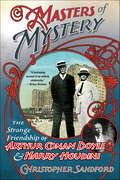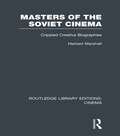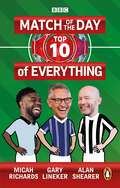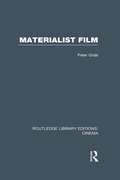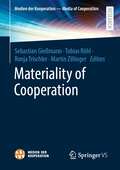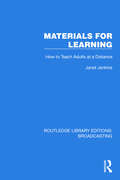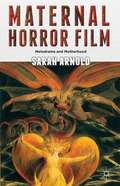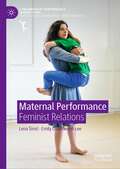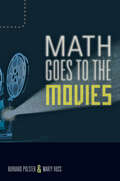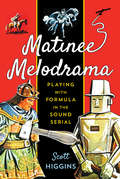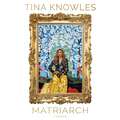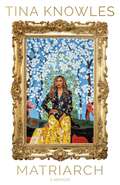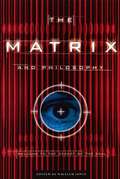- Table View
- List View
Mastering Creative Anxiety: 24 Lessons for Writers, Painters, Musicians, and Actors from America's Foremost Creativity Coach
by Eric MaiselIn his decades as a psychotherapist and creativity coach, Eric Maisel has found a common thread behind what often gets labeled “writer’s block,” “procrastination,” or “stage fright.” It’s the particular anxiety that, paradoxically, keeps creators from doing, completing, or sharing the work they are driven toward. This “creative anxiety” can take the form of avoiding the work, declaring it not good enough, or failing to market it — and it can cripple creators for decades, even lifetimes. But Maisel has learned what sets successful creators apart. He shares these strategies here, including artist-specific stress management; how to work despite bruised egos, day jobs, and other inevitable frustrations; and what not to do to deal with anxiety. Implementing these 24 lessons replaces the pain of not creating with the profound rewards of free artistic self-expression.
Mastering Monologues and Acting Sides: How to Audition Successfully for Both Traditional and New Media
by Janet WilcoxMastering Monologues and Acting Sides: How to Audition Successfully for Both Traditional and New Media is everything an actor needs to be ready for that perfect part, from webisodes to Shakespeare. Scripts, acting technique tips, and exercises keep a performer toned and ready, while industry experts give advice on how to audition professionally. Invaluable Internet listings keep you on top of changing trends, as well. Casting directors, agents, managers, and actors share insights on proper protocol for different performance settings, and practice is made simple with script excerpts and exercises to keep skills sharp for last minute auditions. Includes instructional CD.
Mastering Movement: The Life and Work of Rudolf Laban
by John HodgsonLike Picasso in painting, Stravinsky in music, or Stanislavski in theatre, Rudolf Laban (1879–1958) has been a seminal influence in contemporary arts. This is the first major study of Laban's movement theories and practice, exploring the ideas on mastering movement and giving the reader a practical understanding of balance and harmony in the human body – the core of Laban's thinking. John Hodgson looks at the different phases of Laban's life and writings to show that Laban's thoughts about human movement and its mastery and control are the building blocks for a practical understanding of how the human body can create both beauty and purity through movement.
Mastering Multi-Camera Techniques: From Pre-Production to Editing to Deliverable Masters
by Mitch JacobsonFrom a basic two-camera interview to an elaborate 26 camera HD concert film, this comprehensive guide presents a platform-agnostic approach to the essential techniques required to set up and edit a multi-camera project. Actual case studies are used to examine specific usages of multi-camera editing and include a variety of genres including concerts, talk shows, reality programming, sit-coms, documentaries for television, event videography and feature films. Other features include:* Advanced multi-camera techniques and specialty work-flows are examined for tapeless & large scale productions with examples from network TV shows, corporate media projects, event videography, and feature films. * New techniques for 3D projects, 2k/4k media management and color correction are revealed. * Technical breakdowns analyze system requirements for monitoring, hard drives & RAIDs, RAM, codecs and computer platforms. * Apple Final Cut Pro, Avid Media Composer, Adobe Premiere Pro and several other software programs are detailed.* Tables, charts, screen-grabs, photos, web-links, blogs, tech school lists and other resource tools for further study.* Unique interviews with the 'Masters of Multi-Cam' including EMMY and academy award-winning directors and editors who share their project notes and give insight to award-winning techniques.
Mastering Screenplay Form and Style
by Mick Hurbis-CherrierMastering Screenplay Form and Style shows you how professional screenwriters actually write scripts. This reference manual explores all aspects of the form, from essential format requirements to the expressive, literary qualities of screenplay language. Organized in three parts, this book systematically reveals the full essence of the screenwriter’s craft. The Ground Rules: Take a deep dive into the fundamental rhetorical concepts for dramatizing a story for the screen - the craft and style concepts that underpin everything working screenwriters use. The Industry Standards: Master the professional norms for script formatting and language, including the function and correct use of the six screenplay elements for common, advanced, and challenging narrative situations. Learn methods for indelible character introductions, and managing story and screen time on the page. Expressive Screenwriting: Understand how precise visual writing can infuse your scripts with cinematic energy, dramatic tone, POV, and narrative flow. You will also learn when, why, and how screenwriters bend and even break screenwriting conventions for dramatic impact.. Mastering Screenplay Form and Style is the ideal text to guide screenwriting students and aspiring professional screenwriters to move beyond technically “correct” scripts, to truly captivate readers through compelling screenplays with a distinctive style and voice.
Mastering Shakespeare: An Acting Class in Seven Scenes
by Scott KaiserWho says only the British can act Shakespeare? In this unique guide, a veteran acting coach shatters that myth with a boldly American approach to the Bard. Written in the form of a play, this volume's "characters" include a master teacher and 16 students grappling with the challenges of acting Shakespeare. Using actual speeches from 32 of Shakespeare's plays, each of the book's six "scenes" offer proven solutions to such acting problems as delivering spoken subtext, using physical actions to orchestrate a speech, creating images within a speech, dividing a speech into measures, and much more.
Mastering Stand-Up: The Complete Guide to Becoming a Successful Comedian
by Stephen RosenfieldThis entertaining and sharply written guide—for both beginners breaking into comedy and professionals seeking to improve their sets and advance their careers—examines the work of great comedians such as Louis C.K., Jerry Seinfeld, Eddie Izzard, Moms Mabley, Hannibal Buress, Sarah Silverman, Richard Pryor, and more as a means of illustrating the most important techniques of performing and writing stand-up.Here, Stephen Rosenfield lays out a clear plan for achieving success, candidly explaining what works, what doesn't, and why. Including a 12-item "Successful Comedian's To-Do List," Rosenfield states, "Get undeniably good at each of these and you can kiss your day job good-bye. You will be a pro."The New York Times heralded Stephen Rosenfield as "probably the best known comedy teacher in the country." His alumni include some of today's most prominent comedians and comedy writers, such as Lena Dunham, Jim Gaffigan, Eric Slovin, and Jessica Kirson. Rosenfield has directed, coached, and/or written for these and hundreds of other comedians. As a pioneer in the field of teaching comedy, he founded the American Comedy Institute, the premier stand-up comedy school in the United States, in 1989.
Mastering the Craft of Diverse and Inclusive Screenwriting: Find Your Screenwriting Superpower
by Karla Rae FullerThis accessible and informative textbook provides a guide to the craft of screenwriting with an emphasis on diverse perspectives, underrepresented groups and their screen stories. Readers will learn to master writing a feature-length screenplay in a framework that focuses on diversity, equity and inclusion. With case studies to aid understanding, the book explores the screenwriting process in stages, explaining how to create a logline, as well as character bios, writing and choosing a genre, differentiating between writing a treatment, a synopsis, composing an outline, incorporating the formatting process and finally creating a scene and sequence. The techniques specific to screenwriting will also be covered in the text such as writing dialogue and action, establishing setting and time period and most importantly mastering the craft of visual storytelling. At the same time, the textbook introduces concepts of content choices that are diverse and inclusive, such as stereotypes vs. archetypes, intersectional characters, underrepresented groups and themes such as social justice, systemic racism, class conflict, gender inequity and climate change.Due to its subject matter and inclusive approach, this textbook will be an essential guide for all aspiring and current screenwriters who want to successfully navigate and complement today’s developing industry.
Mastering the Pitch: How to Effectively Pitch Your Ideas to Hollywood
by Scott KirkpatrickTold from the perspective of a Hollywood executive with nearly 20 years’ experience professionally pitching and distributing film/TV projects, Mastering the Pitch reveals all the nuanced details of the pitching process. Readers will gain valuable insights into how the Hollywood system operates, improve their professional pitching skills and gain a competitive edge in getting their ideas from concept to greenlight. This book covers: how projects are packaged and developed before a pitch; how a pitch presentation happens in a real-world setting; the core concepts required to pitch each genre type; how professional companies actually acquire a pitched project; the legal workflows and financial details required to put a deal together; examples of pitch documents, presentation materials and how these elements should be designed; how to build your personal brand so that you’re seen by Hollywood decision makers as someone capable of delivering great projects; and how you should speak to professionals about the business viability of your projects Mastering the Pitch is a valuable crossover text, designed to help both students and veteran film/TV producers alike hone their pitching and presentation skills.
Masters of FX: Behind the Scenes with Geniuses of Visual and Special Effects
by Ian FailesIt would be rare these days to find a film that did not in some way depend on the magic of visual effects, from the raging computer-generated dinosaurs in Steven Spielberg's Jurassic Park, to the fantastical worlds of Tim Burton's Alice in Wonderland, and the photoreal tiger and ocean in Ang Lee's Life of Pi. Through interviews with 16 of the leading effects pioneers from around the world (see list below), author Ian Failes explores the making of some of the most memorable film sequences ever produced, showcasing the shift from practical to digital magic with original behind-the-scenes imagery, shot breakdowns, and detailed explanations of some of the secrets behind the making of cinema's most extraordinary creations. Visual effects artists and films discussed include: Dennis Muren (Star Wars: Episodes IV–VI; Terminator 2: Judgment Day; Jurassic Park; A.I. Artificial Intelligence; War of the Worlds) Bill Westenhofer (Babe: Pig in the City; Cats & Dogs; The Lion, the Witch and the Wardrobe; The Golden Compass; Life of Pi) Joe Letteri (The Lord of the Rings trilogy; King Kong; Avatar; Planet of the Apes; The Hobbit trilogy) Rob Legato (Apollo 13; Titanic; The Aviator; Hugo) Paul Franklin (Pitch Black; Christopher Nolan’s The Dark Knight trilogy; Inception; Interstellar) Richard Edlund (Star Wars: Episodes IV–VI; Raiders of the Lost Ark; Ghostbusters; Multiplicity); Edson Williams (X-Men: The Last Stand; The Curious Case of Benjamin Button; The Social Network; Captain America films) Karen Goulekas (Godzilla; The Day After Tomorrow; 10,000 BC; Green Lantern); Chris Corbould (Golden Eye; Die Another Day; Christopher Nolan’s The Dark Knight trilogy; Inception); Ian Hunter (The X-Files; The Dark Knight; The Dark Knight Rises; Inception; Interstellar) John Rosengrant (Terminator films; Jurassic Park; Iron Man films; Real Steel)
Masters of Light
by Dennis Schaefer Larry Salvato John BaileyThrough conversations held with fifteen of the most accomplished contemporary cinematographers, the authors explore the working world of the person who controls the visual look and style of a film. This reissue includes a new foreword by cinematographer John Bailey and a new preface by the authors, which bring this classic guide to cinematography, in print for more than twenty-five years, into the twenty-first century.
Masters of Light: Conversations with Contemporary Cinematographers
by Dennis Schaefer Larry SalvatoThrough conversations held with fifteen of the most accomplished contemporary cinematographers, the authors explore the working world of the person who controls the visual look and style of a film.
Masters of Mystery: The Strange Friendship of Arthur Conan Doyle & Harry Houdini
by Christopher SandfordRenowned mystery author Arthur Conan Doyle and famous illusionist Harry Houdini first met in 1920, during the magician's tour of England. At the time, Conan Doyle had given up his lucrative writing career, killing off Sherlock Holmes in the process, in order to concentrate on his increasingly manic interest in Spiritualism. Houdini, who regularly conducted séances in an attempt to reach his late mother, was also infatuated with the idea of what he called a "living afterlife," though his enthusiasm came to be tempered by his ability to expose fraudulent mediums, many of whom employed crude variations of his own well-known illusions. Using previously unpublished material on the murky relationship between Houdini and Conan Doyle, this sometimes macabre, sometimes comic tale tells the fascinating story of the relationship between two of the most loved figures of the 20th century and their pursuit of magic and lost loved ones.
Masters of the Soviet Cinema: Crippled Creative Biographies (Routledge Library Editions: Cinema)
by Herbert MarshallEisenstein, Pudovkin, Dovzhenko, Vertov: these Soviet film directors are acknowledged to be among the greatest in the history of cinematography. To Eisenstein we owe such films as Battleship Potemkin and October; to Pudovkin Mother and The End of St Petersburg; to Dovzhenko Earth and Zvenigora; and to Vertov The Man With a Movie Camera and The Three Songs of Lenin. Herbert Marshall knew each of them personally, both as artists and as friends, and shared their cinema world when he was a student at the GIK (The Moscow State Institute of Cinematography) in the heady years following the Revolution into the period of the first Five Year Plan. His material is culled from personal recollections, diaries, notes, unpublished and published biographies, letters, press cuttings, articles and books in various languages, but mainly from Soviet sources and the Soviet cinema world. Taking the subjects one by one, this indispensible book discusses their major films including an account of their creation and reception in the USSR and abroad. It shows the tragedy of these four Soviet artists who were lucky enough not to be arrested or deprived of their limited freedom, yet who nevertheless ended up with ‘crippled creative biographies’. The author then examines the changed viewpoint in the climate of 1983 when the book was originally published.
Match of the Day: Our Ultimate Football Debates
by Gary Lineker Alan Shearer Micah RichardsFootball isn't life or death - it's much more serious than that...Which players will the fans never forget? Who are the Premier League's best buys? Who were the best link ups in history? In Match of the Day Top 10 of Everything, Gary Lineker, Alan Shearer and Micah Richards bring all of the charm, wit and punditry of their hit BBC Sounds podcast onto the page, arguing the toss over their favourite strikers, Premier League managers, shock transfers, cult heroes, hard men, FA Cup Finals, and much, much more. The question is...will you agree with their picks?
Materialist Film (Routledge Library Editions: Cinema)
by Peter GidalA polemical introduction to the avant-garde and experimental in film (including making and viewing), Materialist Film is a highly original, thought-provoking book. Thirty-seven short chapters work through a series of concepts which will enable the reader to deal imaginatively with the contradictory issues produced by experimental film. Each concept is explored in conjunction with specific films by Andy Warhol, Malcolm LeGrice, Lis Rhodes, Jean-Luc Goddard, Rose Lowder, Kurt Kren, and others. Peter Gidal draws on important politico-aesthetic writings, and uses some of his own previously published essays from Undercut, Screen, October, and Millennium Film Journal to undertake this concrete process of working through abstract concepts. Originally published in 1989.
Materiality of Cooperation (Medien der Kooperation – Media of Cooperation)
by Martin Zillinger Tobias Röhl Sebastian Gießmann Ronja TrischlerThe volume investigates the socio-material dimension and media practices of cooperation – before, during and beyond situations. Cooperation is understood as reciprocal interplay operating with or without consensus, in co-presence or absence of the involved actors in distributed situations. Artefacts, bodies, texts and infrastructures are the media that make cooperation possible. They enable and configure reciprocal accomplishments – and are themselves created through media practices in cooperative situations.
Materials for Learning: How to Teach Adults at a Distance (Routledge Library Editions: Broadcasting #26)
by Janet JenkinsMaterials for Learning (1981) examines the ability of books and broadcasts to change lives. The combination of print, radio, television and group meetings – distance teaching – can transform education in developing countries. Effective distance teaching requires effective teaching materials, and up to now there has been a lack of guidance about how to produce such materials and how to do so for different cultures. Materials for Learning aims to supply this need by suggesting guidelines for action and, where evidence is mixed or lacking, defining questions that still require answers. It is a practical book aimed at people actively involved in nonformal education and will be particularly useful for the developing world educators. The book looks first at how distance teaching can help with educational problems, considers how adults learn, and surveys problems of language and culture. It then considers the planning of distance teaching and looks in detail at the use of different media. There were also chapters on teaching numeracy and science at a distance, and a discussion of the kind of support that can be provided for people studying at a distance.
Maternal Horror Film
by Sarah ArnoldMaternal Horror Film: Melodrama and Motherhood examines the function of the mother figure in horror film. Using psychoanalytic film theory as well as comparisons with the melodrama film, Arnold investigates the polarized images of monstrous and sacrificing mother.
Maternal Performance: Feminist Relations (Contemporary Performance InterActions)
by Lena Šimić Emily Underwood-LeeMaternal Performance: Feminist Relations bridges the fields of performance, feminism, maternal studies, and ethics. It loosely follows the life course with chapters on maternal loss, pregnancy, birth, aftermath, maintenance, generations, and futures. Performance and the maternal have an affinity as both are lived through the body of the mother/artist, are played out in real time, and are concerned with creating ethical relationships with an other – be that other the child, the theatrical audience, or our wider communities. The authors contend that maternal performance takes the largely hidden, private and domestic work of mothering and makes it worthy of consideration and contemplation within the public sphere.
Math Goes to the Movies
by Burkard Polster Marty RossMel Gibson teaching Euclidean geometry, Meg Ryan and Tim Robbins acting out Zeno's paradox, Michael Jackson proving in three different ways that 7 x 13 = 28. These are just a few of the intriguing mathematical snippets that occur in hundreds of movies. Burkard Polster and Marty Ross pored through the cinematic calculus to create this thorough and entertaining survey of the quirky, fun, and beautiful mathematics to be found on the big screen. Math Goes to the Movies is based on the authors' own collection of more than 700 mathematical movies and their many years using movie clips to inject moments of fun into their courses. With more than 200 illustrations, many of them screenshots from the movies themselves, this book provides an inviting way to explore math, featuring such movies as:• Good Will Hunting• A Beautiful Mind• Stand and Deliver• Pi• Die Hard• The Mirror Has Two FacesThe authors use these iconic movies to introduce and explain important and famous mathematical ideas: higher dimensions, the golden ratio, infinity, and much more. Not all math in movies makes sense, however, and Polster and Ross talk about Hollywood's most absurd blunders and outrageous mathematical scenes. Interviews with mathematical consultants to movies round out this engaging journey into the realm of cinematic mathematics.This fascinating behind-the-scenes look at movie math shows how fun and illuminating equations can be.
Matinee Melodrama
by Scott HigginsLong before Batman, Flash Gordon, or the Lone Ranger were the stars of their own TV shows, they had dedicated audiences watching their adventures each week. The difference was that this action took place on the big screen, in short adventure serials whose exciting cliffhangers compelled the young audience to return to the theater every seven days. Matinee Melodrama is the first book about the adventure serial as a distinct artform, one that uniquely encouraged audience participation and imaginative play. Media scholar Scott Higgins proposes that the serial's incoherent plotting and reliance on formula, far from being faults, should be understood as some of its most appealing attributes, helping to spawn an active fan culture. Further, he suggests these serials laid the groundwork not only for modern-day cinematic blockbusters like Star Wars and Raiders of the Lost Ark, but also for all kinds of interactive media that combine spectacle, storytelling, and play. As it identifies key elements of the serial form--from stock characters to cliffhangers--Matinee Melodrama delves deeply into questions about the nature of suspense, the aesthetics of action, and the potentials of formulaic narrative. Yet it also provides readers with a loving look at everything from Zorro's Fighting Legion to Daredevils of the Red Circle, conveying exactly why these films continue to thrill and enthrall their fans.
Matriarch: Beyoncé’s mother tells her story for the first time ever
by Tina KnowlesTo understand the icons Beyoncé, Solange and Kelly, you have to understand where they came from... A deeply personal and revelatory memoir by Ms Tina Knowles - as you've never seen her before.Tina Knowles, the mother of icons Beyoncé Knowles-Carter, Solange Knowles and bonus daughter Kelly Rowland, is known the world over as a Matriarch with a capital M: the woman who raised and inspired some of the great artists of our time. But this story is about so much more than that.For the first time ever, Tina Knowles shares her remarkable story in Matriarch. A life of grief and tragedy, love and heartbreak, the nurturing of her superstar daughters - and the perseverance and audacity it takes for a girl from Galveston, Texas to change the world.This intimate and revealing memoir is a multigenerational family saga and a celebration of the wisdom that women, mothers and daughters pass on to each other across generations.A glorious chronicle of a life like none other and a testament to the world-changing power of Black motherhood.
Matriarch: Beyoncé’s mother tells her story for the first time ever
by Tina KnowlesTo understand the icons Beyoncé, Solange and Kelly, you have to understand where they came from... A deeply personal and revelatory memoir by Ms Tina Knowles - as you've never seen her before.Tina Knowles, the mother of icons Beyoncé Knowles-Carter, Solange Knowles and bonus daughter Kelly Rowland, is known the world over as a Matriarch with a capital M: the woman who raised and inspired some of the great artists of our time. But this story is about so much more than that.For the first time ever, Tina Knowles shares her remarkable story in Matriarch. A life of grief and tragedy, love and heartbreak, the nurturing of her superstar daughters - and the perseverance and audacity it takes for a girl from Galveston, Texas to change the world.This intimate and revealing memoir is a multigenerational family saga and a celebration of the wisdom that women, mothers and daughters pass on to each other across generations.A glorious chronicle of a life like none other and a testament to the world-changing power of Black motherhood.
Matrix and Philosophy: Welcome to the Desert of the Real
by William IrwinThe thought-provoking essays discuss different facets of the primary philosophical puzzle of The Matrix: Can we be sure the world is really there, and if not, what should we do about it? Other chapters address issues of religion, lifestyle, pop culture, the Zeitgeist, the nature of mind and matter, and the reality of fiction.
